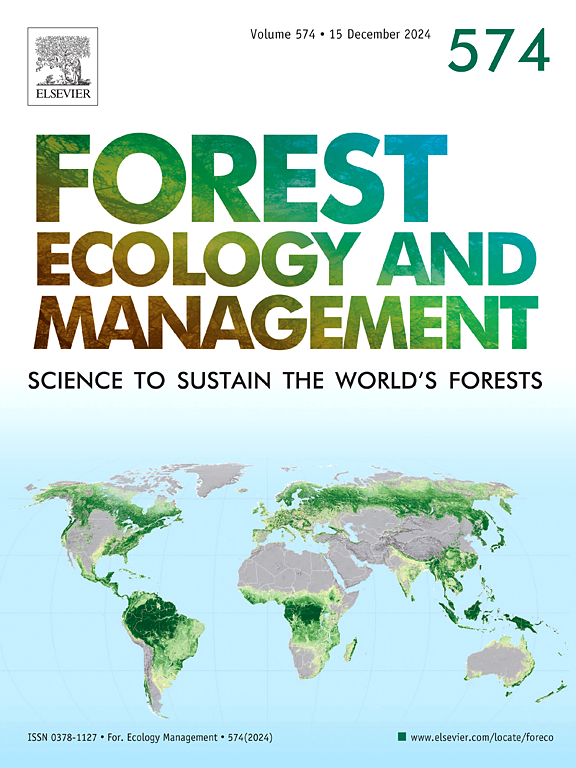新热带稀树草原森林损失和隔离对植物-蝙蝠相互作用的影响
IF 3.7
2区 农林科学
Q1 FORESTRY
引用次数: 0
摘要
人类导致的栖息地丧失和隔离对生物多样性产生了严重影响,对植物与动物的相互作用产生了间接影响。基于对巴西Serra da Bodoquena国家公园周围20个地点进行的为期7年的调查,我们研究了森林损失和与大型连续森林的隔离(距离)如何影响植物-蝙蝠相互作用网络。结果表明:在1 km半径的缓冲地带,森林覆盖率为30 ~ 70% %的景观中,蝙蝠种类较多(9种:r²= 0.50,p = 0.01;24种植物:r²= 0.54,p = 0.001)和相互作用比极端情况下(森林被严重砍伐或完全森林覆盖的景观)的相互作用要大。植物-蝙蝠网络也更大、更模块化(0.60),连通性较低(0.18),在中等森林覆盖值的景观中比在极端森林覆盖值的景观中(r²= 0.51,p = 0.03;R²= 0.73,p = 0.002;分别)。相互作用蝙蝠的丰富度(9种)和网络模块化度(0.60)在距离公园连续林10 km处高于距离公园连续林近或远的地点(r²= 0.39,p = 0.05;R²= 0.54,p = 0.002;分别)。总体结果表明,森林损失和与公园隔离对植物-蝙蝠网络的大小和结构产生非线性影响,中等水平的森林覆盖和隔离支持更大、更模块化的网络。这些结果突出了在人类改造景观中保留相当面积的森林遗迹的重要性,以及大型保护森林在维持授粉和种子传播方面的关键作用。本文章由计算机程序翻译,如有差异,请以英文原文为准。
Forest loss and isolation effects on mutualistic plant-bat interactions in a Neotropical savanna
Human-induced habitat loss and isolation have severe impacts on biodiversity, with indirect effects on plant-animal interactions. We investigate how forest loss and isolation (distance) from a large continuous forest affect mutualistic plant-bat interaction networks based on a seven-years survey across 20 sites surrounding the Serra da Bodoquena National Park, Brazil. Our results showed that landscapes with 30–70 % forest cover at 1 km-radius buffer had more species (9 bat species: r² = 0.50, p = 0.01; 24 plant species: r² = 0.54, p = 0.001) and interactions than those at the extremes, either heavily deforested or fully forested landscapes. Plant-bat networks were also larger and more modular (0.60), with lower connectivity (0.18), in landscapes with intermediate than in extremes forest cover values (r² = 0.51, p = 0.03; r² = 0.73, p = 0.002; respectively). Richness of interacting bats (9 species) and network modularity (0.60) were higher at 10 km from the park’s continuous forest than in sites closer or further away (r² = 0.39, p = 0.05; r² = 0.54, p = 0.002; respectively). Overall results indicate that forest loss and isolation from the park nonlinearly affect the size and structure of plant-bat networks, with intermediate levels of forest cover and isolation supporting larger and more modular networks. These outcomes highlight the importance of keeping a considerable area of forest remnants in human-modified landscapes, and the crucial role of large protected forests to maintain pollination and seed-dispersal plant-bat interactions.
求助全文
通过发布文献求助,成功后即可免费获取论文全文。
去求助
来源期刊

Forest Ecology and Management
农林科学-林学
CiteScore
7.50
自引率
10.80%
发文量
665
审稿时长
39 days
期刊介绍:
Forest Ecology and Management publishes scientific articles linking forest ecology with forest management, focusing on the application of biological, ecological and social knowledge to the management and conservation of plantations and natural forests. The scope of the journal includes all forest ecosystems of the world.
A peer-review process ensures the quality and international interest of the manuscripts accepted for publication. The journal encourages communication between scientists in disparate fields who share a common interest in ecology and forest management, bridging the gap between research workers and forest managers.
We encourage submission of papers that will have the strongest interest and value to the Journal''s international readership. Some key features of papers with strong interest include:
1. Clear connections between the ecology and management of forests;
2. Novel ideas or approaches to important challenges in forest ecology and management;
3. Studies that address a population of interest beyond the scale of single research sites, Three key points in the design of forest experiments, Forest Ecology and Management 255 (2008) 2022-2023);
4. Review Articles on timely, important topics. Authors are welcome to contact one of the editors to discuss the suitability of a potential review manuscript.
The Journal encourages proposals for special issues examining important areas of forest ecology and management. Potential guest editors should contact any of the Editors to begin discussions about topics, potential papers, and other details.
 求助内容:
求助内容: 应助结果提醒方式:
应助结果提醒方式:


